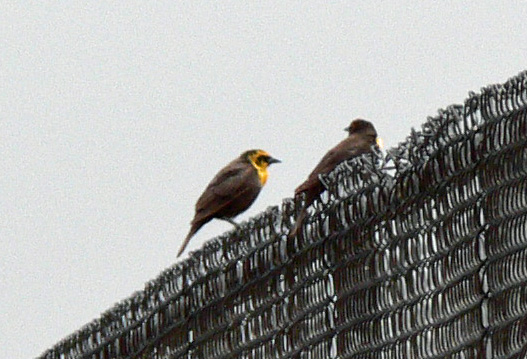#420 Yellow-headed Blackbird at the UCI Arboretum
Sometimes you have to work for a bird, and sometimes it shows up in your backyard. In this case, it showed up in the backyard of my office, which happens to be an area of the UCI Arboretum that’s not open to the public. However, you can still stand on Fairchild Road and peer over the fence. That’s what Robert McNab did on May 7 as he recounted on the OrangeCountyBirding mailing list:
I was leaving work today (~ 3:45P) and decided to look at the blackbird flock in the high dry grass near my work that I had been glancing at all day. Turned out to be 36-50 YELLOW-HEADED BLACKBIRDS with nearly the same number of Mourning Doves (and Nutmeg Mannikins) feeding in a field adjacent to the UCI – closed marsh area west of Campus drive. The flock was inside the black cyclone fence area at the north end of the FDA building, 19701 Fairchild Drive, Irvine, CA. Fairchild is a connector road between MacArthur and Jamboree Roads at the Irvine/Newport Beach boundary near Upper Newport Bay. Many birds were on the fence itself nearest the marsh and farthest the street and should be visible to non-FDA employees if you look from Fairchild Drive. Parking may be a little tricky, but where there is a will, there is a way!.
I was out of town and didn’t get the message until Thursday evening, May 8, so I didn’t get out to look for them until Friday, May 9. I checked in the morning before I went to work, but no blackbirds were to be found. I checked again in the afternoon after lunch. I walked from the FDA complex down to MacArthur and then down MacArthur pretty much all the way to San Joaquin Creek and back. I was about to give up but then just past the FDA complex in the other direction I spotted these two lovely ladies perched on a chain link fence:

I went back and found them again on Monday, but after that they did not reappear.
Besides, these two lifers, the site was surprisingly birdy. Here are some of the other species I saw just from walking partway around the edge:
- Great Blue Heron
- Snowy Egret
- Turkey Vulture
- Northern Harrier
- American Coot
- Forster’s Tern
- Mourning Dove
- Western Kingbird
- American Crow
- Tree Swallow
- Cliff Swallow
- Song Sparrow
- Red-winged Blackbird
- Yellow-headed Blackbird
- House Finch
I can only imagine what you could see inside if it were open to the public.

May 24th, 2008 at 9:19 PM
“I can only imagine what you could see inside if it were open to the public.”
Perhaps less: the point of keeping the public out of some areas is to encourage birds that can’t tolerate too much human contact.
May 26th, 2008 at 11:25 PM
True that. I am reminded of a mountain range that overlooks the White Sands missile range in New Mexico which, at least as of 15 years ago, had one of the largest populations of mountain lions anywhere precisely because it had been completely closed off from human encroachment for almost any reason.
That being said, most birds really don’t care about people very much at all. It’s shocking how little concern some of them pay to us. The real key is habitat preservation. Everything else is a second order effect at best. As long as managers resist the urge to cut paths everywhere, build nature centers and install picnic tables, and focus on education instead of conservation (easier to get money when you can appeal to parents’ desires to ditch their children for a few hours) then it doesn’t matter a great deal whether or not a few hikers wander through.
The real challenge in this particular space, like most preserves in urban and suburban areas, is invasive species, both plants and animals. The preserve has the highest density of the invasive Brown Garden Snail I’ve ever seen. I’m not sure what the situation is with the plants out here, but it’s usually a battle to keep the ornamentals from moving in and choking off everything native.